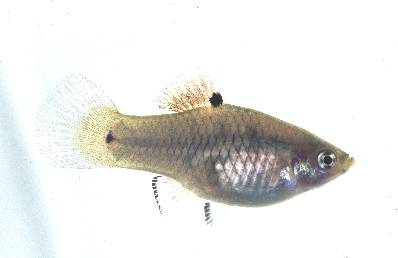

Xiphophorus fish, commonly known as platyfish and swordtail, is a genus of fish that consist of 26 species, and commonly found in Central and South America. Xiphophorus maculatus (X. maculatus) represents a long-standing genetic model that was adopted into studies dissecting the etiology of tumoregenesis. The most commonly used lines of X. maculatus are Jp163A (JpA), and Jp163B (JpB). The founder individuals of JpA and JpB were initially siblings by a single X. maculatus female that was collected in Jamapa River in late 1930’s, but exhibited very different pigmentation patterns: JpA is characterized by spotted dorsal (sd) pigmentation pattern, and JpB is characterized by spotted side (sp) pigmentation pattern.
A special feature that renders the Xiphophorus fishes an attractive genetic model is they can produce viable interspecies hybrids that allow shuffling and recombining of alleles that were diverged 7-8 million years ago, allowing genetic mapping of locus controlling particular phenotype. For example, the inter-allelic interaction in interspecies hybrids creates a genetic background that increases pigment cell tumor susceptibility in select hybrid progeny. An oncogene termed Xiphophorus melanoma receptor kinase (xmrk), is a mutant copy of fish egfr gene, and accounts for the pigment cell tumoregenesis of Xiphophorus interspecies hybrid. The xmrk oncogene was shown to drive the dedifferentiation and proliferation of neural crest lineage. The sd (JpA) and sd (JpB) locate very close to the xmrk gene and therefore co-segregate with the xmrk during meiosis. Therefore, Sd and Sp were hypothesized to control the neural crest lineage distribution (i.e., dorsal fin, or side of the body).
Interspecies hybrids between JpA and X. hellerii, is a result of Mendelian segregation between the xmrk oncogene and a hypothetical tumor suppressor named R(Diff). In parental X. maculatus JpA, the xmrk is repressed by the R(Diff), therefore the JpA only exhibit spotting pattern. When JpA is crossed to X. hellerii, a Xiphophorus species that dose not have either of the xmrk, or the R(Diff), the F1 interspecies hybrid inherited one copy of the xmrk, but also lost one copy of the R(Diff), resulting in hyperplasia of pigmented cell in the F1 interspecies hybrid. When backcrossing the F1 to the X. hellerii, 25% of the backcross progeny inherited the xmrk oncogene, but not the R(Diff) exhibited spontaneous melanomagenesis. Therefore, this model system represented an example of genetic background-controlled tumoregenesis.
The genome of the X. maculatus (Jp163A) was sequenced and assembled into chromosomes. The genome sequences can be downloaded from Ensembl (http://useast.ensembl.org/index.html), and NCBI (https://www.ncbi.nlm.nih.gov/assembly/GCF_002775205.1).
The platyfish DNA for single molecule real time (SMRT) sequencing is derived from a single male (Xiphophorus maculatus, Strain - JP 163 A) from the Xiphophorus Genetic Stock Center (Dr. Ron Walter, Director), Texas State University, San Marcos, Texas, USA. X. maculatus Jp 163 A are line bred (i.e., brother-sister matings) and this fish is from the 114th generation if line breeding. Sequences were generated on the Pacific Biosciences Sequel instrument (V2 chemistry) to approx. 83x genome coverage based on a genome size estimate of 700 Mb. All SMRT sequences were assembled with the HGAP4 algorithm (SMRT Link v5.0.1.9585) then error corrected using the Arrow error-correction module. Additional polishing of the assembly for residual indels was done by aligning 50x coverage of Illumina data and the Pilon algorithm. Scaffolds were generated by alignment to a Bionano map created with the same DNA source using the Irys software. Finally, all scaffolds were ordered and oriented by alignment to the genetic linkage map using Chromonomer (http://catchenlab.life.illinois.edu/chromonomer/.cite). Of the 704 Mb assembled genome (X_maculatus-5.0), the total assembly N50 contig and scaffold lengths are 9.2Mb (n=259) and 31.5Mb (n=103), respectively.
ASSEMBLY STATS: SCAFFOLDS COUNT 103 LENGTH 704,304,639 bp AVG 6,837,909 bp N50 31,535,491 bp LARGEST 35,293,739 bp Scaffolds > 1M: 24 ( 699,980,690 bp ) 99.4% Scaffolds 250K--1M: 1 ( 269,636 bp ) 0.04% Scaffolds 100K--250K: 14 ( 1,854,102 bp ) 0.26% Scaffolds 10K--100K: 52 ( 2,150,311 bp ) 0.31% Scaffolds 5K--10K: 5 ( 37,383 bp ) 0.005% Scaffolds 2K--5K: 3 ( 9,783 bp ) 0.001% Scaffolds 0--2K: 4 ( 2,734 bp ) 0.0004% CONTIGS COUNT 259 LENGTH 700,976,734 bp AVG 2,706,473 bp N50 9,181,372 bp LARGEST 26,812,185 bp Contigs > 1M: 115 ( 664,204,175 bp ) 94.8% Contigs 250K--1M: 54 ( 30,725,410 bp ) 4.4% Contigs 100K--250K: 26 ( 3,846,938 bp ) 0.55% Contigs 10K--100K: 52 ( 2,150,311 bp ) 0.31% Contigs 5K--10K: 5 ( 37,383 bp ) 0.005% Contigs 2K--5K: 3 ( 9,783 bp ) 0.001% Contigs 0--2K: 4 ( 2,734 bp ) 0.0004%
For details of other Xiphophorus species, please see Fish resources
For questions, please contact XGSC: xiphophorustsu@gmail.com